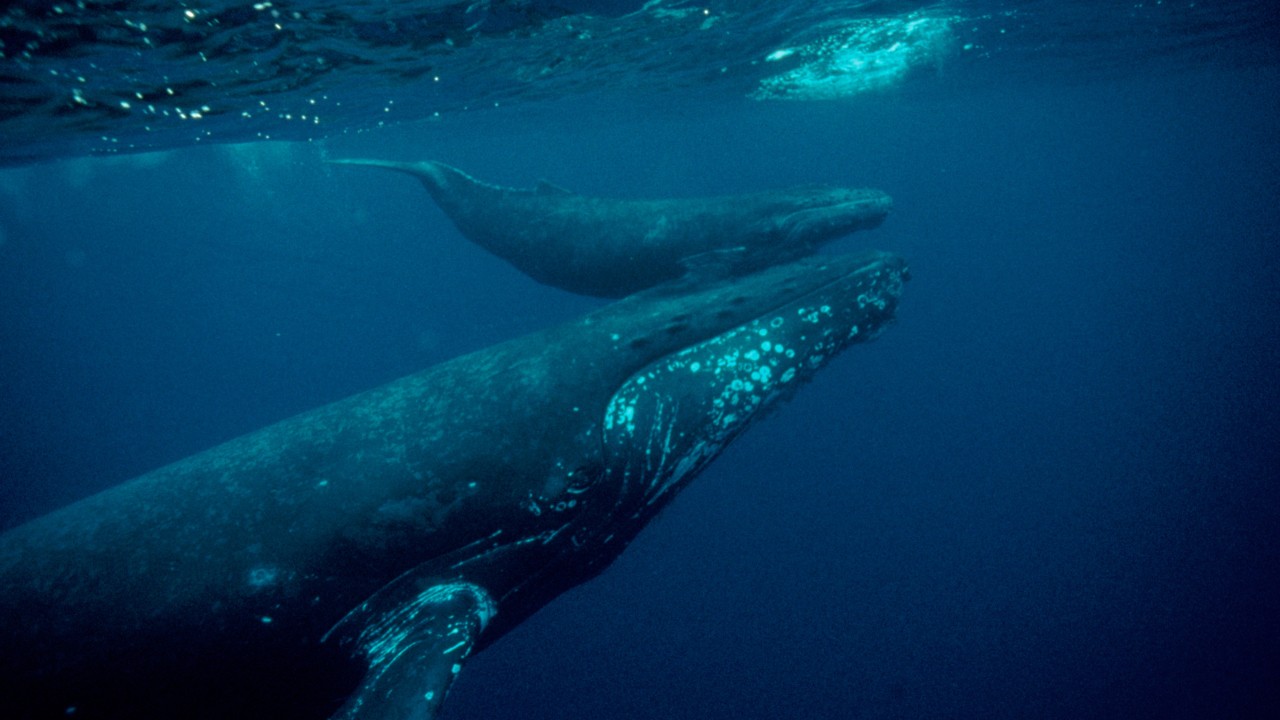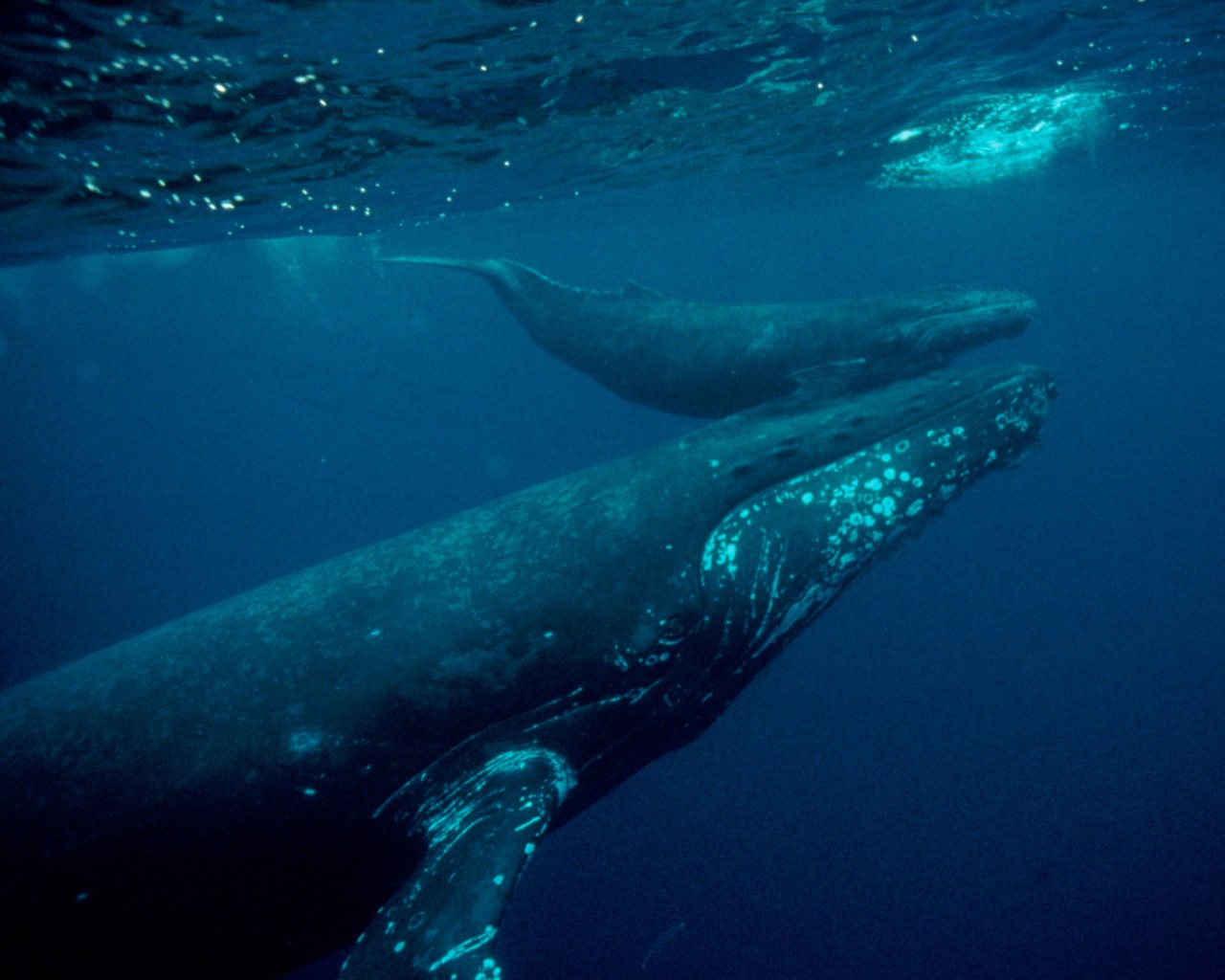

Photograph by Georgette Douwma / NaturePL
WORDS BY AJDINA HALILOVIC
Every now and then, a song rises above the noise and lingers for a while. Tracks like “Yesterday” from The Beatles or John Lennon’s “Imagine” might come to mind. Nature, too, has its anthems. Just ask University of Queensland’s Dr. Michael Noad, a marine scientist who has witnessed humpback whale songs take over ocean soundscapes time and time again.
Humpback whales are ocean giants with a knobbly head and elongated flippers. Males sing remarkably structured songs, likely as part of their mating behavior. The shortest sound discernible to the human ear is called a unit. Several units form a phrase; phrases combine into themes; and themes, arranged in a precise sequence, make up a song—which a whale, usually suspended in a haunting display, head down and flukes up near the surface, might repeat for hours on end.
“But the extraordinary thing is not just the structure of the song,” Noad said—it’s that all the whales within a population sing the same song within any given season. A behavior shared across a population, passed down through social learning rather than genes, and differing between populations, is what scientists define as culture. For humpback whales, song is just that. “And yet the pattern of the song changes gradually over time,” he added. The song changes in most humpback populations every few years; but all the males adopt the same changes more or less at the same time.
In 1996, Noad was recording songs of the eastern Australian population of humpback whales, which followed a well-defined, easy-to-learn pattern. But the following year, something strange happened. During the northward migration, he began hearing two different songs: one familiar and one entirely new. “It was almost a flip of a coin,” Noad said. The observation challenged everything he thought he knew. “Well, they haven’t read the textbooks, but they’re not supposed to do this,” Noad said to himself. A few months later, as the whales began returning south, the old song had completely died out.
“We take it for granted when it’s there, but when it’s disrupted, that’s when we notice something is wrong.”
Preparing a conference talk on the mysterious new song, Noad decided—out of pure scientific thoroughness—to compare it to recordings from other regions. He got hold of a tape from Western Australia and slid it into the recorder, not expecting it to have anything to do with the east Australian song because, as he put it, “it never has.” But as the recording began to play, he went still. The song was exactly the same as the new one that had appeared. “It was so much the same, I actually thought I’d put the wrong tape in,” Noad said.
That day in 1998, in his office at the University of Sydney, Noad uncovered tangible evidence of a rapid, Beatlesque cultural revolution among whales: A song crossed the ocean, cleared a population boundary, and eclipsed what had come before. These song revolutions, it later turned out, happen every few years. More than a decade after his original discovery, Noad and his collaborators found that the leaps don’t stop there. A year later, a new song would appear in New Caledonia, and a year after that, in French Polynesia, in what scientists have aptly come to call “cultural ripples.”
Humpback whale song now provides one of the clearest examples of animal culture, but it’s far from the only one. Though culture was previously thought to be unique to humans, a growing body of research finds evidence in species of all ilk, from elephants to bumblebees. This includes critical survival skills, such as migration. On a rapidly changing planet, cultural traits are invaluable: The behavioral flexibility they afford helps certain species to adapt to human-modified ecosystems. Now, as climate change and habitat loss hurtle species toward extinction, conservationists and scientists are advocating for the protection of animal cultures before it’s too late.
For whales, which Noad describes as “devilishly hard to study,” evidence of culture can be elusive. Occasionally, though, they grace scientists with something to observe. One example is a hunting technique called wave-washing, used by killer whales in Antarctic waters to wash seals off ice floes. The behavior, thought to be practiced by only about 100 individuals, involves a group of whales moving as one, triggering waves with intent and turning water into a hunting tool.
In another first-of-its-kind observation in the inland waters of Washington, killer whales were seen shaping a piece of seaweed, placing it between themselves and another whale, and rubbing it over one another’s skin. Researchers suspect this kind of massage may help maintain skin health and strengthen social bonds.
Although examples of cetacean culture are mounting, Noad admits a pang of envy toward scientists who can observe their subjects more directly: the “bird people,” as he calls them.
About a decade ago, in the woodlands of Oxfordshire, England, behavioral and cognitive ecologist Dr. Lucy Aplin set out to understand how innovative animal behavior spreads. She trained a few yellow-bellied birds, called great tits—each slightly heavier than a walnut in its shell—to open puzzle boxes by sliding a small door to the left or right to reach a hidden mealworm. When these trained birds, drawn from different populations, were released back into the wild, the technique they had learned cascaded through their social groups. Hundreds of untrained birds copied them, some pushing right, others left, leading to “these really established cultures that were very persistent over time,” Aplin said.
Birdsong is another classic example of animal culture, said Aplin, now at the University of Zurich in Switzerland. Culture also shapes how birds feed and migrate—the latter of which demonstrates the clear importance of culture in conservation.
Take the whooping crane, a tall bird with white plumage, black wingtips, and a stiletto-like beak. By 1941, only 21 wild individuals remained. Captive breeding programs had to get creative to bring them back. The birds first needed to be raised by what resembled an adult crane: a silent human cloaked in white, with a crane-head puppet slipped over one hand. But releasing the birds posed another challenge. Conservationists had to teach them a key part of their culture: how to migrate.
Traditionally, young cranes learn their routes by following older, more experienced birds. So humans did the next best thing: costumed pilots flew ultralight aircraft, guiding juveniles along ancestral paths. Over time, the birds learned and began passing that knowledge on. The species has now rebounded to around 600 individuals. “It’s a fantastic example of animal culture and conservation in action,” said Aplin.
It was the breakdown of migration culture that exposed just how vulnerable animals become when their shared knowledge collapses. “We take it for granted when it’s there, but when it’s disrupted, that’s when we notice something is wrong,” said Dr. Shermin de Silva, a conservation scientist at the University of California, San Diego and the founder of the conservation nonprofit, Trunks & Leaves.
A changing world doesn’t just erase existing cultures: it creates new ones. As the Arctic continues to warm, hungry polar bears are digging muzzle-deep into garbage dumps instead of hunting seals on sea ice—an increasingly common behavior that’s problematic for both bears and humans. When we think of dumpster-diving, the word culture may not come up, de Silva explained. “But that’s what’s going on.”
We’ve long assumed animals are born knowing what to eat and where to go, de Silva pointed out—but that’s simply not true. “It’s helpful to think about culture as this alternative inheritance mechanism,” she said. Noad likes the term second inheritance. And in a world struck by change, this second inheritance might offer a rapid way for populations to adapt, Aplin added. Aplin has seen this firsthand: In a follow-up study with her right- and left-pushers, birds were quick to switch sides when the payoff changed. “They were pretty successful at this,” she said. For animals caught in the whirlwind of unprecedented planetary change, culture is the one inheritance evolving fast enough to keep up.
Yet conservation policies, for the most part, have been slow to reflect this understanding. They “usually tend to be crafted around numbers,” de Silva said. And that’s no longer enough. Culture, once considered rare and confined to a select few, is emerging as widespread—and, for some in the animal kingdom, foundational. “The more we look for it, the more we find it,” said Noad.
When Noad first recorded the dramatic song change in 1997, two singers stood out. While most whales were either singing the old song or the new one, that particular duo seemed caught in between, weaving together full themes from both. These were the first “hybrid singers” ever recorded. Years later, Noad, together with marine scientist Dr. Ellen Garland, found that humpback whales learn songs theme by theme, making these in-between songs a fleeting trace of a culture in transition.
For a researcher used to studying what’s hidden, the hybrid songs were a rare gift: proof that while their learning remains largely out of our sight, animal culture is real, discernible, and—yes—conservable to those who know how to listen.
Animal Cultures, Under Rising Threat, Are Key To Species Survival